The Corsair CS450M PSU Review
by E. Fylladitakis on June 10, 2015 8:00 AM EST- Posted in
- PSUs
- Corsair
- Cases/Cooling/PSUs
- 80Plus Gold
External Appearance
When you are on a tight budget, aesthetics are of secondary importance, but they are rarely ever of no importance at all. Corsair realizes that and they kept the appearance of the CS450M relatively plain but aesthetically subtle. Perhaps even overly subtle, as almost everything on the CS450M is black. The steel chassis has been sprayed with a matte black paint, a standard round black finger guard stands above the black cooling fan and the cables are entirely black as well. Only the side stickers with the company and series logo intrude on the blackness of the CS450M.
Other than that, the CS450M is built inside a standard, ATX-compliant 140 mm steel chassis. A sticker with the electrical and safety specifications of the PSU can be seen at the top side of the chassis. There is virtually nothing of real importance at the rear of the chassis, only a basic on/off switch and an AC power cable receptacle. Four cable connectors for the modular cables can be found at the front of the chassis.
Internal Design
Yate Loon supplies the black 120 mm fan responsible for the cooling of the CS450M. It is a rather basic model, with a sleeve bearing engine and a maximum speed of 1,650 RPM. Considering the small power output and efficiency of the CS450M, this fan should never go anywhere near its maximum speed to maintain low operating temperatures.
Corsair entrusted the CS450M to Great Wall, a Chinese OEM that we are not very accustomed to seeing. As a matter of fact, no other PSU that we have ever seen uses this particular platform, so either Corsair designed it themselves and Great Wall is just building the PSUs, or Great Wall is allowing Corsair to use it exclusively. It does not matter either way, as the quality and performance of the PSU are what actually matters to the consumer. As far as quality is concerned, CS450M is substantially better than we initially anticipated considering the retail price of the PSU.
The filtering stage is textbook, with four Y capacitors, two X capacitors and two filtering inductors. One of the X capacitors, the one at the back of the AC receptacle, is a little oddly placed, with wires connecting it to the PCB and the body of the capacitor glued on the back of the PCB itself. An effective but very crude solution to the space problem. A NTC thermistor blocks large inrush currents and a simple relay short-circuits it once its job is done. The primary capacitor of this particular unit is relatively small and the inrush current should not reach noteworthy value, but Corsair is using the same platform for many other products, including models nearly twice as powerful, with much higher capacitance.
The primary side heatsink holds the main rectifying bridge, the active PFC components and the primary inversion transistors. The PFC inductor is a sealed type, meaning that the naked large inductor has been replaced by a black plastic block. Theoretically, this could suppress the generation of "coil-whine" noise problems, as that high frequency sound originates from the high frequency vibrations of the inductors under electromechanical stress. Surprisingly, the primary PFC capacitor is supplied by Rubycon and is rated at 400V/390μF. Rubycon is one of the most reputable capacitor manufacturers and we rarely see their products used outside premium products, so finding one in the CM450M is, mildly put, unexpected.
Meanwhile the secondary conversion transistors generate the 12V line, while the 3.3V/5V lines are being derived from it using DC-to-DC conversion circuits. A small transformer is present for the generation of the 5VSB line as well. The secondary capacitors are a very complex mixture of electrolytic and polymer capacitors alike. The electrolytic capacitors are supplied by Nippon Chemi-Con, Teapo and CapXon, while the polymer capacitors are a mix of Teapo and Chinsan products.


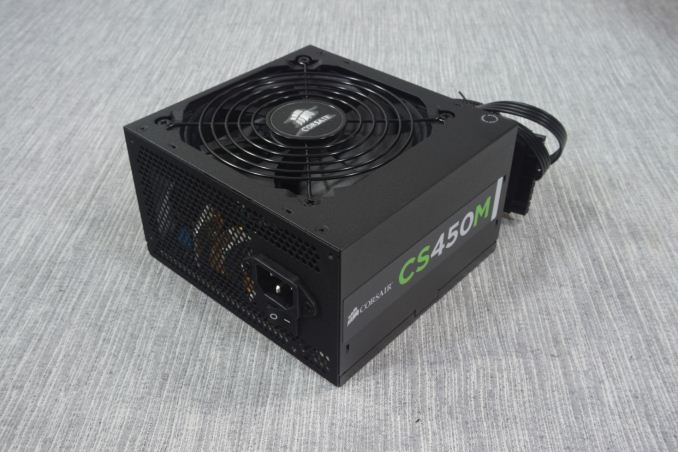





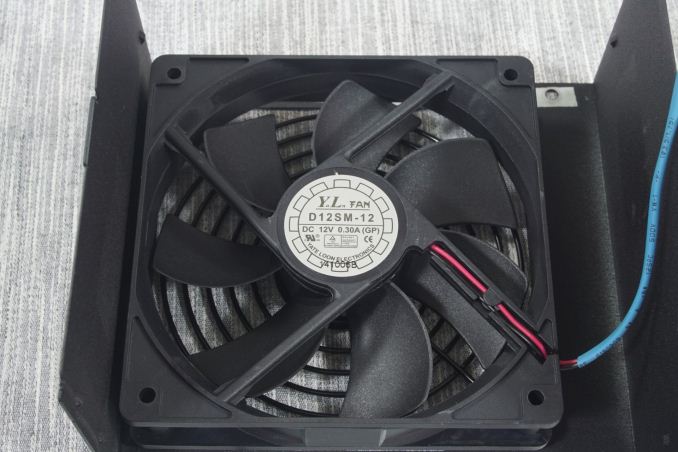
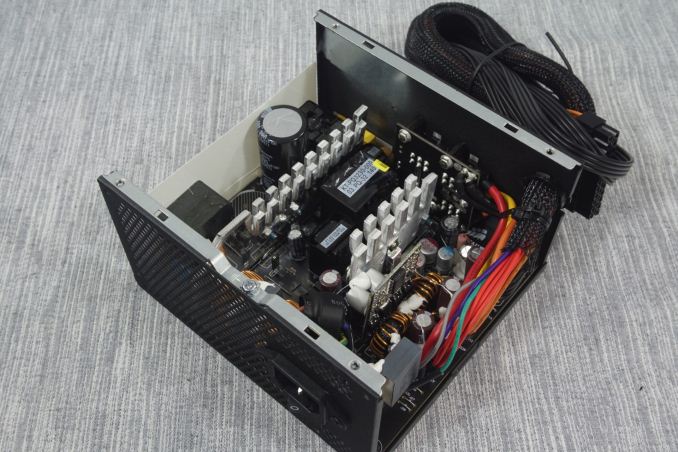

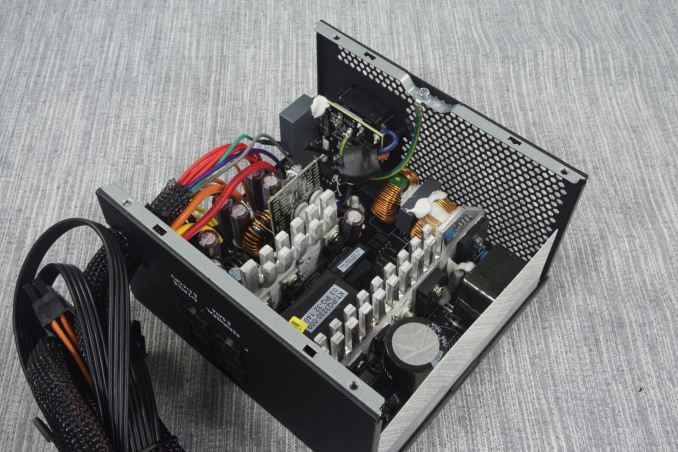
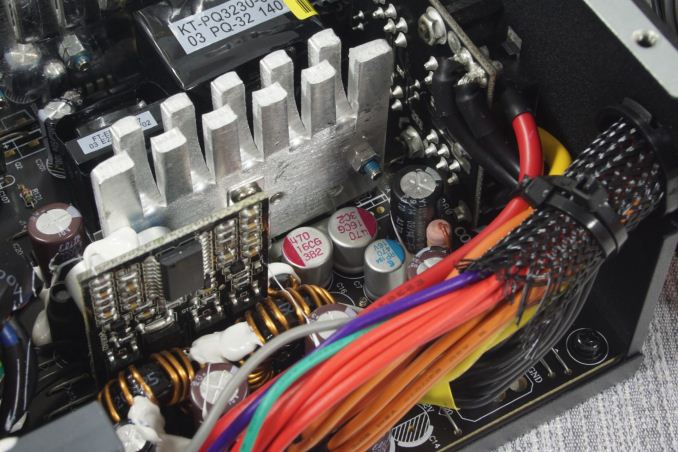








46 Comments
View All Comments
Black Obsidian - Wednesday, June 10, 2015 - link
I've used a number of CS450M and CS550M PSUs for budget builds, since they can both regularly be found <$50 (and sometimes <$40, in the case of the reviewed model).I've been relying on the Corsair name and warranty as a proxy for actual PSU quality, and I'm quite happy to hear that the quality I'd been assuming actually exists.
Thanks for prodding manufacturers to provide reasonable-wattage PSUs for review, Fyll!
Computer Bottleneck - Wednesday, June 10, 2015 - link
It actually drops to $26.99 after rebate on a fairly regular basis at Newegg.MapRef41N93W - Thursday, June 11, 2015 - link
You've been relying on the wrong company then as Corsair are known to release lots of dodgy PSU's in the past. Their "I" series PSUs are hot garbage and usually a complete waste of money compared to the standard series. Their RM series beyond 550 watts suffers from horrible ripple voltage issues. Their CX series (one of the most popular PSU lines due to their extremely cheap price) are not something that should ever be paired with a "high end" setup (like a 4790k/GTX 980) and yet we see this all the time.Never trust a single brand of PSUs and always check the OEM of the unit you are buying first. The only real exception to this is Seasonic as they make most of their own PSUs.
Zap - Thursday, June 11, 2015 - link
What is this "horrible ripple" that you speak of? Does it not stay within ATX specifications and manufacturer claims? Or does it just not measure up to "enthusiast" expectations?I did a quick search and found "Why you might not want to buy a Corsair RM PSU" on overclock.net which referenced a TechPowerUp review of the RM1000 as showing the worst performance. The review mentioned a few places where it "failed" such as exceeding ATX specifications for 3.3v ripple at 110% output and OTP triggered at 45°C. Note that both failures exceeds specifications (Corsair rates this PSU to only 40°C).
The only real fail is in hold-up time, which failed to meet ATX specifications. This would be a good reason to not get this particular PSU, especially if power in your area fluctuates more than normal.
These PSUs are a far cry from the true "crap" units. Diablotek anyone? Deer? Apevia?
Flunk - Thursday, June 11, 2015 - link
Diablotek units are just as likely to destroy your entire system as work properly so that's not a very good comparison. The previous poster has a point that Corsair's power supplies have a checkered history with certain series (like the CX) being notoriously poor. Maybe this new CS series is them trying to improve their low end offerings, but because Corsair sources power supplies from many, many companies you have to be careful buying from them. Some of their power supplies are great, some are not so great. It's not like Seasonic where they build all their own power supplies.Zap - Friday, June 12, 2015 - link
My point was that there is a difference between "will destroy your computer" and "horrible ripple but still in spec."PICman - Wednesday, June 10, 2015 - link
Your reviews are excellent, thanks! For the power efficiency tests, was your mains voltage 220V? Maybe it is listed, but I missed it.Wwhat - Wednesday, June 10, 2015 - link
There is a link to 'how do we test', on that link page it says:"We should note that all testing is being performed with a 230V/50Hz input, delivered by a 3000VA VARIAC for the perfect adjustment of the input voltage. "
Incidentally 230V is the EU standard.
ATC9001 - Wednesday, June 10, 2015 - link
I understand that high end (i.e. reliable and consistent) equipment for electronics can be expensive, but PLEASE try to convince anandtech to foot the bill so we can get 120V and 230V!Great review though, thank you!
leexgx - Saturday, June 13, 2015 - link
230v is optimal for PSUs , where as USA it can be as low as 90V or as high as 120V (why HardOCP tests there PSUs at low voltage as well)